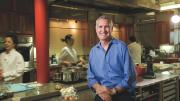In 2003, Ferran Adrià appeared on the cover of the New York Times Magazine, becoming only the second Spaniard, after Salvador Dalí, to do so. Like Dalí, Adrià is both an artist and a kind of surrealist. His restaurant, elBulli, on the Costa Brava north of Barcelona, has attracted every honor a chef could hope for. In 1997 Guide Michelin awarded it a three-star rating, making it then only the third such restaurant in Spain. (There are only 96 Michelin three-star restaurants in the world today, and just nine in the United States.) The industry benchmark, Restaurant Magazine, declared elBulli the top restaurant in the world a record five times between 2002 and 2009.
Open just six months a year—Adrià and his colleagues devote their annual “downtime” to creating an entirely new menu—elBulli seats only 8,000 diners annually. Yet a reported two million e-mails flood in on the single October day that the restaurant accepts reservation requests. (Adrià has announced that elBulli will close on August 1, to reopen in 2014 as a creativity center.)
Deploying elements like liquid nitrogen, Adrià shatters cooking conventions and analyzes recipes with an exactitude that rivals science. (In fact, after a 2008 guest lecture at Harvard, this proponent of “molecular gastronomy” signed an agreement for a collaboration with Harvard physicists and engineers—see “The Harvard Center for Gastrophysics?” March-April 2009, page 13—which led to an undergraduate course on the science of cooking.)
His work has intrigued other scholars as well. Consumer-behavior specialist Michael Norton, associate professor of business administration, wrote (with Julian Villanueva and Luc Wathieu) “elBulli: The Taste of Innovation,” a 2008 Harvard Business School teaching case on Adrià’s eatery. “High-end consumers are interested in eating as an experience,” Norton explains. “There’s a rise in top restaurants that cater to people wanting not just a great steak, but outlandish food, something that no one else in the world offers. For wealthy people, this is part of a broader trend, a shift from buying stuff to buying experiences: travel, instead of big cars. At elBulli, the food is extraordinary but the experience is even more extraordinary.”
That experience starts a year before the meal, when a diner wins the lottery and receives a reservation, “so you have a year of anticipation,” says Norton, who has dined there. From Barcelona, there’s a two-hour drive through sparsely populated mountains—“You can get lost,” he reports. On arrival, Adrià personally greets his guests, who receive a guided tour of the kitchen, which is larger than the dining area. “Then you sit down and have this amazing, crazy meal,” Norton says. “You drive back late at night—and tell people about it for the rest of your life.”
Adrià has little interest in preparing the world’s best bouillabaisse; what would interest him might be turning the ingredients of bouillabaisse into a pyramid of foam that tastes exactly like bouillabaisse should. He has served ravioli made of transparent agar-agar jelly rather than pasta, putting the filling on view. For the “nitro caipirinha” cocktail, a waiter trundles in a trolley with liquid nitrogen (at -196 degrees Celsius), which precedes the cocktail into the drinking vessel and instantly freezes it to a sorbet: the guest then eats the cocktail with a spoon, before it melts.
ElBulli may be the apotheosis of restaurant dining as a form of theater: foodstuffs become the raw material of art, not nutrition. The eating experience decouples itself almost entirely from food’s functional attributes: sustenance, nourishment, health. Though the food is unquestionably delicious, even the sensations of taste and texture may knuckle under to the goals of displaying the chefs’ imaginations and startling the diner with a meal’s originality. “Creativity comes first,” Adrià says, in Norton’s case study. “Then comes the customer.”
Entrées and Ego
“The advent of celebrity chefs and cooking-as-entertainment have influenced the way people eat in restaurants, and made chefs a lot more self-conscious,” says Mollie Katzen, the Berkeley, California-based author of the Moosewood Cookbook, who is something of a celebrity chef herself, having hosted cooking shows on television and sold more than six million cookbooks under 15 different titles. “It’s not that I don’t enjoy a good meal in a restaurant—I do. But with chefs trying to make names for themselves—it’s so competitive—a lot of times it’s about trying to be clever, rather than just trying to be delicious. I had a meal the other day in a new restaurant here that’s getting a lot of press for all its local sourcing and so on—and the food was extremely precious, very fussed-over and complicated. There was a lot of discussion with the waiter about what you were getting; it was a big, ornate deal. And it didn’t taste all that good! Just give me a beautiful, perfectly prepared salad. I don’t want a cerebral experience in a restaurant—I’m not going for entertainment.”
Since 2003, Katzen has been a consultant to the Harvard University Dining Services (see “Delicious Minimalism,” September-October 2006, page 32) and is co-creator of its Food Literacy Project. She is also a charter member of the Harvard School of Public Health Nutrition Roundtable. “I love going to an ethnic hole-in-the-wall that serves, say, a beautiful Vietnamese pho,” she says. “But for American, nouvelle, fusion, French, Italian, it will still be a six- or eight-ounce hunk of animal protein in the center of the plate and some token vegetables. I want a maximum of three ounces of meat or fish and at least 80 percent of my meal to be plant foods. Entrées are never less than $25 anymore, and I often end up feeling I had way too much salt. Insecure chefs salt up the food—I’ve had to send $30 plates back because the food was so salty that I found it inedible. It just doesn’t feel that honest to me; the creativity is a little too fraught. There’s a lot of ego on that plate.
“I used to eat out a lot, and now I eat out very, very little,” she continues. “Eating a good, simple, home-cooked meal is almost always my preference. Every now and then I think, ‘I’ll give it another chance’—and then I do, and it confirms that I don’t want to keep doing this. If I’d eaten at home it would have been healthier, simpler, and way more what I want it to be.”
Moms with Menus
The simple fact, though, is that Americans are eating more of their meals away from home. The National Restaurant Association reports that the fraction of Americans’ food budgets spent in restaurants has about doubled since 1955, from 25 to 49 percent. Restaurant industry sales have zoomed up from $42.5 billion in 1970 to an anticipated $604 billion this year: adjusted for inflation, a 2.5-fold increase.
Those restaurant meals are in large measure replacing home-cooked ones—a transformation that affects our health, weight, finances, and family lives. Yet “home-cooked” retains an irreducible cachet; its positive associations are so strong that restaurant menus often tout “home-cooked” items that are, of course, nothing of the sort.
“Professionally cooked” is becoming the norm. “There’s a convergence of factors,” says Walter Willett, Stare professor of epidemiology and nutrition and chairman of the department of nutrition at the Harvard School of Public Health (HSPH). “Americans are more time-pressured than before and most families have two people working outside the house—there isn’t somebody at home who has time to shop and prepare meals. As real wages have gone down, Americans have maintained a fairly flat family income by putting another person into the workforce, and that’s cut down on discretionary time in a major way.”
“I have friends in their forties who grew up right at the height of Mom never being in the kitchen,” says Katzen, who co-wrote Eat, Drink, and Weigh Less (2006) with Willett. “They didn’t see their mothers in the kitchen in any meaningful way—it wasn’t an integral part of life in the home. So they were opening a lot of cans, or buying fast food. In my [baby-boom] generation, our mothers lived in the kitchen; that’s where they parked themselves during the day and held court. In my family, at dinnertime, the kids would all help with the final steps: setting the table, helping Mom get the food on the table, helping clear afterwards. It was a team activity, part of what we did together as a family. My guess is that an equally, if not more, common way to gather around food now is to sit around the TV and watch Top Chef.”
Demographic changes have no doubt affected eating patterns. Compared to the 1950s, there are now relatively more divorced adults, more single-parent and single-person households, and more two-income households whose earners haven’t time to cook dinner. All these groups may eat out or order take-out meals for convenience and/or conviviality. Technological innovations such as the microwave oven, and the increased availability of salad- and entrée-bar fare, also enable people to quickly prepare meals at home that are not “home-cooked.”
Restaurants have also changed vastly since the 1950s. About half are now fast-food establishments, a category that has burgeoned in recent decades. Adding table service, as at Denny’s or International House of Pancakes, moves establishments up a notch to “family dining.” Add a liquor license (and omit breakfast service) for the “casual dining” category, where average 2009 checks ranged from $11 to $20 per person in the “Big 7” chains: Applebee’s, Red Lobster, Chili’s, Olive Garden, Ruby Tuesday, Outback Steakhouse, and TGI Friday’s. At the pinnacle of the restaurant pyramid, “fine dining” draws loads of attention on food programs but only 1 to 5 percent of the market.
Fine-dining places typically serve only dinner, mid-scale eateries offer lunch and dinner menus, and low-end places cook all three, or just breakfast and lunch. Time spent at a restaurant rises with the bill. Gourmets and gourmands linger hours over multicourse French dinners, but at fast-food eateries, customers may never even set foot inside—they simply buy meals at a drive-through window.
The growth of fast food has clearly increased the number of meals eaten out, if not their unit cost: eating breakfast at a restaurant was once a special occasion, but now McDonald’s tries to persuade commuters to stop by every morning for a coffee and Egg McMuffin. The pace of meals, and their circumstances, can influence menu offerings. “Urban sprawl and urban flight have made commute times longer, squeezing out time for breakfast at home,” says the business school’s Norton. “People leave for work at 6 a.m. and eat in the car. Food design takes this into account: can this be eaten in the car? That’s one reason we see so many sandwiches and bite-sized foods like Chicken McNuggets appearing in the marketplace in recent decades.” Cizik professor of business administration Clayton Christensen notes that in designing milkshakes for commuters, vendors may choose an optimal thickness based, not on taste or texture, but on the duration of the average commute, which dictates how long the milkshake should last before melting.
Fast, Cheap, and Out of a Bowl
In general, restaurant food is far costlier than homemade. Katzen points out that it is “incredibly economical to prepare your own meals. You can spend $1.50 to make your own sandwich, or buy one for $10. It’s easy to spend a couple thousand dollars a year on lunch sandwiches!”
Yet at the fast-food end, economies of scale and efficiencies of mass production mean that “you cannot cook more cheaply than a McDonald’s,” says John “Doc” Willoughby ’70, for nine years executive editor of Gourmet magazine, and currently executive editor for publications at Boston Common Press, publishers of Cook’s Illustrated. “Fast-food joints are the enemy of home cooking. It’s definitely easier, probably cheaper, and unfortunately a kind of food that many have gotten used to eating. There are studies now showing that if you eat a constant diet of fast food, you get addicted to the high fat and sugar content of it, just as if it were a drug—so food without that content doesn’t satisfy you.”
Those same economies of scale that help restaurant chains keep prices down can also make food a generic commodity, with a consequent compromise of quality. Locally owned eateries can more easily buy fresher, local ingredients. “We did a story in Gourmet about small family-owned restaurants being put out of business by chains,” Willoughby says. “You need community support for these restaurants, even if they cost a bit more than the chain. If a restaurant is owned by someone in your town, if you can afford it, you should go there.”
There is also the health fallout from fast food to consider. “Unfortunately, [fast food] has had an adverse effect on nutritional status and the obesity epidemic,” says Willett. “It’s not that eating out is a problem—it’s the food people eat in restaurants. Due to our dominant Northern European eating culture, Americans value quantity over quality: if you get a bigger serving, that’s value.”
In 2002, researchers Lisa Young and Marion Nestle of New York University reported that restaurant portion sizes began growing in the 1970s, rose sharply in the 1980s, and “have continued in parallel with increasing body weights.” One reason KFC can undersell the home cook (though their labor and real-estate costs likely outstrip those for foodstuffs) is that “the basic ingredients of unhealthy food are incredibly cheap,” Willett explains. “White starch and sugar cost next to nothing. So you can make huge serving sizes—30-ounce sodas, for example—and people think they’re getting value.”
The large portions often consist of cheap items: sugars, starches, and refined carbohydrates like pasta, all highly caloric. A 2002 report from the U.S. Department of Agriculture indicated that in the 1994-96 period, Americans consumed 25 percent of all meals and snacks—but 32 percent of all calories—away from home. Upscale eateries, too, dish out ample doses of costlier, but still fattening, ingredients. “[A]t your favorite restaurant, chances are, you’re eating a ton of butter,” wrote chef Anthony Bourdain in his 2000 memoir, Kitchen Confidential. “In a professional kitchen, it’s almost always the first and last thing in the pan….Believe me, there’s a big crock of softened butter on almost every cook’s station, and it’s getting a heavy workout.”
Big portions mean big consumption. “People eat what is on the plate,” says assistant professor of business administration Jason Riis, a consumer psychologist who is studying overeating. “It is tough to take the rest home.” He cites an experiment by food psychologist Brian Wansink, author of Mindless Eating, who experimented with a “bottomless” bowl of soup (unobtrusively replenished by a pipe hidden beneath the table) at the Cornell University Food and Brand Lab. Subjects thought they ate the same amount as when using a normal soup bowl, but in fact ate 73 percent more. “We use spatial cues as to when to stop eating,” Riis says. “If there is more on the plate, we eat more.”
The current American epidemic of obesity (its prevalence has doubled since 1980) owes much to large portions—especially sweet, liquid ones. “Sugared beverages are the single most important source of needless calories in the U.S. diet,” says Willett. “They’re 7 to 9 percent of consumption. If you could get rid of those, almost half of the obesity epidemic would disappear.”
Riis and his colleagues have tried asking patrons in fast-food eateries if they might like to try “downsizing” instead of “supersizing” their meals. Even without any price discount, about a third of the customers were willing to take smaller portions—an option not usually offered. Riis’s investigation suggests that offering varied portion sizes could reduce restaurant expenses while still satisfying customers.
Home on the Range
Ironically enough, along with the burgeoning of restaurants has come a simultaneous revival of the domestic culinary arts. That movement may have begun with Julia Child, but now embraces thousands of books, magazines, and 24-hour television outlets like the Food Network, legions of websites, gourmet foodstuff suppliers, and grassroots savants in their home kitchens. Call it the Williams-Sonoma revolution: by any name, the new passion for good home cooking may represent a countertrend to the influx of restaurants.
Authors like Katzen are pushing back against the dining-out juggernaut. In her most recent cookbook, Get Cooking (2009), she wrote, “Somehow, as our options have increased—from restaurants and take-out to more and more frozen heat-and-eat options of every kind—the fine, ancient craft of cooking has become something of a lost art.” For her, cooking “is a life skill, our birthright as human beings: knowing how to cook and feed ourselves. It connects you back to yourself and to the community. My parents looked on getting a driver’s license not as a privilege but a responsibility. I feel the same way about cooking. It becomes a whole craft: a skill that forces you to plan, to concentrate, to execute, to put events in a certain chronological order. It keeps your mind sharp. Cooking is a meditation.”
The danger as cooking becomes glamorized—producing rock-star chefs and glitzy television series—is that, just as with restaurant meals, cooking will be turned into another form of theatrical entertainment. Contemporary food television sets a different goal from its forebears. The earlier generation of cooking programs was instructional, attempting to teach viewers the skill, Willoughby says. Furthermore, “Julia Child is very unintimidating. She drops things, forgets things, she makes mistakes, and tells you it will all come out OK. But today, most of food television is not instructional. Viewers are just watching a talented chef cook, and getting a vicarious experience of cooking. It’s like a celebrity reality show. These are professional chefs doing things in the kitchen that you cannot do—and that’s not what home cooking is about.”
Spectacularly entertaining gourmet shows can thus become an enemy of home cooking by implicitly suggesting that “everything has to be perfect,” Willoughby declares. “Then people start feeling that they are unable to cook well—so they’re not going to cook at all. People have become very intimidated by cooking, and they shouldn’t be. If you publish a recipe with a mistake in it, you very rarely get letters saying, ‘You screwed up this recipe.’ What you get are letters saying, ‘I made a mistake somehow when I made this—can you tell me what I did wrong?’ Today there’s a supposition on most people’s part that they don’t know how to cook, and therefore it’s their mistake.”
Thus, a central challenge for home-cooking advocates is to give people confidence that—much of the time, anyway—they can make better food at home than they are likely to get in most restaurants. “There will always be a future for home cooking,” Willoughby says, “because there are people who like to cook, and people who have to cook. Plus, it has a social payoff: cooking for yourself or your family leads to social cohesion. And it can be fun!” Cook’s Illustrated, the magazine Willoughby works on, and the related PBS television show, America’s Test Kitchen, stick to practical matters: “How do I make mashed potatoes so that they come out every time the way I want them?” as he puts it.
To reap the rewards of home cooking demands an investment of the same factor whose scarcity helped fuel the rise of restaurants: time. “It bothers me when people say it doesn’t take any more time to cook at home than to eat out,” says Willoughby. “That’s not true. It does take more time: you have to shop, for one thing. But it’s worth it: you get a better result. You can do this.”
The underlying fact is that there is always enough time to do the things we set as priorities. “There’s something about our culture: people are willing to spend an unmeasured amount of time sitting in front of the TV and passively taking in food as entertainment,” says Katzen. “But God forbid taking 20 minutes to cook. I don’t know anybody who keeps track of the amount of time they spend cruising around online and reading blogs. But people are very resistant to the amount of time it takes to cook something. They have to understand that the point of cooking is not to see how little time you can spend doing it.”









